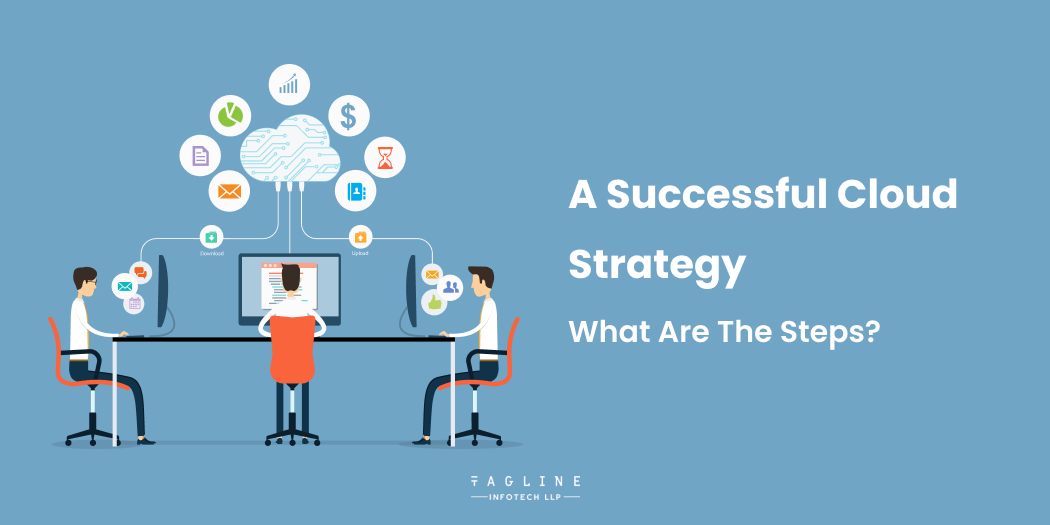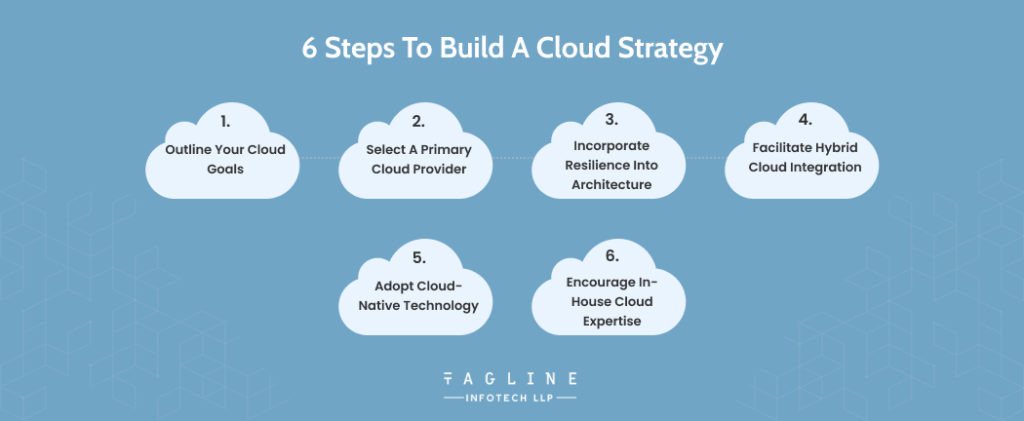How ChatGPT and RPA are Transforming Automation’s Future
May 17, 2024
Home >> Cloud Computing >> A Successful Cloud Computing Strategy: What Are the Steps?

Quick Summary
Businesses may leverage the potential of cloud computing to increase operational efficiency, reduce costs, and preserve competitive advantage when they have a well-thought-out Cloud Computing Strategy. This post will break down the process into six crucial components and provide practical insights to help you navigate your way to the cloud. The blog covers various subjects, such as building business value and speed initiatives and developing internal cloud expertise.
As modern businesses expand, the cloud strategy will be used regularly. It is essential nowadays for driving scalability, innovation and agility for enterprises catering to various sizes. Our guide will help you know about different cloud strategies and their importance in businesses today.
A well-crafted plan outlining how a company will use cloud computing resources to achieve its objectives is called a cloud strategy. This paper provides a roadmap for choices, expenditures, and activities related to adopting and utilising cloud computing.
A cloud strategy is now necessary for businesses that wish to remain in the modern day, given the digital transformation that has occurred in today’s world, where data is king and agility is crucial.
Many businesses see the benefits of using cloud computing as an efficient tool for quickly bringing solutions for processes and business-critical applications to market. However, implementing cloud computing without a clear strategy and plan of action is inefficient and almost certainly leads to problems. The business must have a well-thought-out cloud strategy implementation process before being prepared to make wise and deliberate decisions about cloud projects. Through the essential procedures covered in this guidebook, you will be assisted in developing a successful cloud strategy.

Several cloud solutions are available for you to choose from, but ultimately, your decision should be based on your company’s needs and scalability.
First, Let’s examine each cloud approach’s components:
Under the Single Public cloud approach, the provider offers software, cloud storage, and computing on a pay-as-you-go basis. This implies that you only have to pay for the resources you use. Public cloud providers oversee millions of data centres spread around the globe to guarantee constant throughput and availability.
Businesses that wish to spend less money on maintaining their legacy infrastructure while still being able to focus on their core business operations can benefit from the idea of adopting the public cloud.
Cloud computing allows you to control the cloud where your apps and data are hosted. A data centre on the property houses the cloud provider’s technological stack, customized to meet the company’s needs. Businesses concerned about their employees’ data security and cannot bear the danger of transferring critical data off-site can benefit from the private cloud solution.
An enterprise using numerous cloud service models (IaaS, PaaS, and SaaS) of the same kind (private or public) from various cloud providers is said to be implementing a cloud strategy. Another name for this tactic is hybrid cloud computing. There is a widespread misperception that a hybrid cloud is the same as a multi-cloud strategy. However, this is untrue.
A hybrid cloud combines elements of both public and private clouds. A hybrid cloud strategy is the best option for businesses since it lets them move some apps to the public cloud and keep others on-premises. Companies find this approach appealing. Every firm will operate in a hybrid state as they migrate to the cloud. This is the scenario when you have moved some applications to the cloud and kept others running locally.
“Lift and Shift Migration: Everything You Need to Know “
– Also Read Article

A carefully thought-out cloud strategy is more than just a catchphrase; it’s a vital tool for companies trying to stay ahead of the competition and build for the future. If your company is new or you have upgraded from a legacy system, check out these advantages of a cloud strategy. The following are some benefits of having a well-thought-out and implemented cloud strategy:
Modern businesses must react swiftly to changing market conditions. Cloud approaches enable businesses to scale their resources up or down in response to demand, fostering agility. They also provide access to many cloud-native tools and services, which promotes innovation and shortens the time it takes to launch new products and services.
By paying for only the resources they use, cloud computing allows enterprises to do away with the need for significant upfront capital investments. A prudent cloud approach will help you keep costs under control by maximizing resource allocation, preventing waste, and utilizing the affordable pricing options cloud providers offer. You’ll be able to control costs by doing this.
Organisations require more information technology as they grow. Implementing cloud techniques facilitates seamless scalability, ensuring infrastructure can grow or shrink in line with business needs. It is vital to have this flexibility to handle sudden spikes in demand or workload fluctuations.
Cloud-hosted solutions offer strong capabilities for disaster recovery and business continuity. You may minimize downtime in unanticipated disruptions by implementing a well-defined cloud strategy for protecting your data and apps.
Empower your business with the expertise of our Cloud Computing Strategy
Hire our expert developers to navigate the path to success in the dynamic world of cloud solutions

Here are the seven steps for building a cloud strategy:
The main draw of the cloud is its ability to provide businesses with speed, agility, and value effectively. The first step in creating a cloud data strategy that will enable you to successfully take advantage of these related benefits should be outlining your company goals.
Ascertain the purpose for which you intend to use cloud computing. Is the objective to improve client experiences, save operating expenses, or keep a competitive edge over other companies by creating cutting-edge goods and services?
After identifying your goals, plan for the critical IT skills needed to support them. Considerations for optimizing operations include moving critical workloads to the cloud, utilizing cloud-native technologies, and putting automation and orchestration into place. It is crucial to build your cloud system to be an agile and fast-moving machine while keeping it in line with your overarching business objectives.
Businesses are adopting multi-cloud architectures more frequently to reduce vendor lock-in, increase redundancy, and have access to a more excellent range of services. While multi-cloud computing offers many advantages, it may also introduce complexity if not managed effectively. That being said, it is critical to prioritize primary cloud providers.
Your chosen service provider should fit your company’s needs and objectives best. Some considerations should go into your decision-making process, such as the services’ accessibility, price, compliance requirements, and regional presence.
After selecting your primary supplier, you can examine secondary providers for specific workloads or disaster recovery scenarios. Prioritizing a single supplier simplifies the management process, lowers complexity, and fosters more profound expertise in the platform of your choice.
The cloud does not inherently ensure resilience, even though it offers high availability and redundancy. You should include resilience into your architecture to ensure that your apps will always be usable and functional. Workload distribution across different availability zones or regions is required to prevent catastrophic failures.
Load balancing and auto-scaling ought to be employed to maintain consistent performance during spikes in traffic. It’s critical to put backup and disaster recovery plans into place and test them frequently to ensure they work. By incorporating resilience into your cloud strategy, you may prevent interruptions and the loss of all of your company’s data.
Hybrid cloud architectures are growing in popularity due to their adaptability. These solutions combine public and private clouds with on-premises infrastructure. To enable hybrid architectures, your cloud data strategy must consider how to link and manage resources across various environments seamlessly.
A unified infrastructure can be established by employing hybrid cloud management tools, direct connections, and virtual private networks (VPNs). It is crucial to secure data between cloud environments and on-premises systems while maintaining centralized control and visibility. By implementing hybrid architectures, your company can balance the benefits of cloud-based innovation and the dependability of on-premises infrastructure.
Containers and serverless computing are two examples of cloud-native technologies essential to maximizing the cloud’s potential. You should integrate these technologies into your application development and deployment processes to get the most out of your cloud strategy.
Platforms such as Kubernetes enable the usage of containers, which improve the consistency and scalability of application deployment across cloud environments. Their utilization offers improved resource efficiency, scalability, and portability. Conversely, serverless computing frees developers from managing infrastructure, allowing them to focus solely on developing code. By including these cloud-native technologies in your plan, you may reduce operational overhead, boost productivity, and shorten the time it takes to launch new apps.
Effective management and optimization of cloud resources by your company are crucial elements of a successful cloud strategy. Make sure your company has the necessary resources to carry this out. Public cloud providers offer abundant training materials, certifications, and learning paths to help your staff become proficient in the cloud.
Invest in continuing education for your IT staff, motivate them to earn pertinent certifications, and stay current on cloud computing best practices. To help your company pool its expertise and encourage insight sharing, consider creating a cloud centre of excellence (CoE). By developing public cloud computing skills within your company, you may reduce your dependency on outside consultants and close the skills gap. By doing this, you can manage your cloud resources more independently.
Setting a priority list for several vital lessons learned and recommended practices is essential when creating a successful cloud strategy. The first and most crucial requirement for any cloud strategy must be inextricably linked to your company’s overall business goals. It should also catalyse to enhance consumer experiences, reduce operating expenses, or promote innovation. Every decision you make when utilizing the cloud should be directly related to achieving these objectives. This will guarantee that your cloud investments will pay off in quantifiable ways.
The main benefit of using a cloud-first strategy is that it directly connects with the application whenever your business tries to make it more scalable and easily accessible.
A cloud strategy team in your business ensures that all your business priorities and cloud adoption methods are maintained for better results in favor of your business.

Digital Valley, 423, Apple Square, beside Lajamni Chowk, Mota Varachha, Surat, Gujarat 394101
+91 9913 808 2851133 Sampley Ln Leander, Texas, 78641
52 Godalming Avenue, wallington, London - SM6 8NW